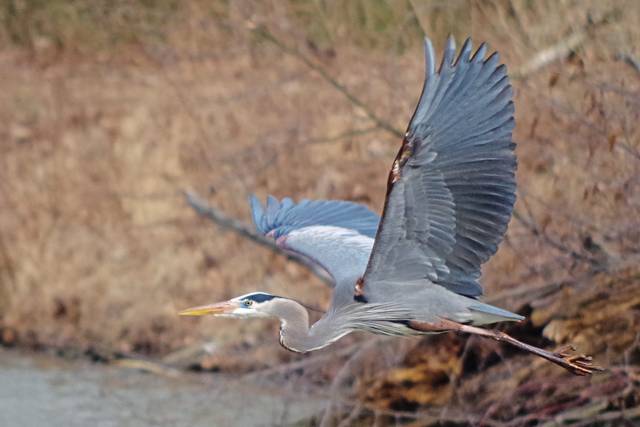Great blue herons common, interesting birds
Imagine a prince, tall and angular, or a princess, long and curvy. Either with a rakish bit of long, flowing hair, dark, piercing eyes and a regal way of moving. They seem all grace and refinement.
Royal, almost.
And then …
“SQUAAAAWK!”
They open their mouth and the noise that comes out is nails-on-a-chalkboard grating.
So it is with great blue herons.
Few would consider their “song” — especially the alarm croak they make when disturbed into flight — melodic or pretty. Harsh is a better description.
But that doesn’t make the birds any less fascinating.
This is a great time of year for observing them, too. Common across all seasons in about three quarters of the U.S., great blue herons are almost nationwide in their distribution and will be through fall.
Breeding season is the reason why.
Great blue herons, which choose a different mate every year, begin nest building in February. It’s a communal affair.
A male and female build a nest together. What’s more interesting is pairs of birds cluster together, sometimes by the dozens or even hundreds, in rookeries or heronries.
These groups of nests are sometimes high in trees, sometimes closer to the ground. But they are always in isolated, hard-to-reach areas where the birds feel safe from intruders.
Females lay two to six eggs, though just a percentage hatch and survive long-term.
Young great blue herons begin to look like adults around June. They will, according to Wild Maryland 101, leave the nest for good by late summer.
Some will live a long time.
“Many young herons will die before they perfect their survival skills, but a heron that can survive past its third year can live for over two decades,” Wild Maryland said.
The oldest known great blue, according to the Cornell Lab of Ornithology, was 24 years old.
Such a life span, combined with the ability to produce multiple young each year, has served the species well.
According to National Geographic, great blue herons are, across their range, considered a species of “least concern,” given their numbers seem to be increasing.
“The great blue heron is one of the most widespread and adaptable wading birds in North America,” Cornell added.
Their willingness to eat just about anything helps make them so.
Herons are generally thought of as a water bird, one that makes its living eating fish, frogs, crayfish and the like around lakes, rivers, streams, marshes and other waterways. They thrive in such environments.
“Certain adaptations help a heron wade about and catch prey in shallow water,” says the Pennsylvania Game Commission. “The most obvious is its legs, which elevate the bird above the water surface.”
A great blue’s toes make it an effective water’s edge predator, too. They’re long and flexible for walking or standing on soft ground.
Then there’s the bird’s head and neck.
“The bill is sharp-tipped, but it’s used for grasping, not impaling. The long, muscular neck delivers a lightning-quick blow, with plenty of force to penetrate the water and seize a fish,” the commission adds.
But great blue herons don’t necessarily need water either.
According to Audubon, they are known to hunt fields and meadows for everything from mice and voles to gophers and other birds. In some locations, they will especially turn to such areas when waterways freeze over.
No matter where you find them, there’s no mistaking them.
Great blues are the largest species of heron in North America. According to Cornell, adults can stand 4 1/2-feet tall and have a wingspan of 6 1/2 feet.
Shy birds, they won’t stand much in the way of intrusion, so getting an up-close look at one can be tough (though they will submit to quiet inspection by a paddler more so than a person on foot).
Still, even watching one fly away can be a thrill.
They coil their neck into an S-shape, stretch their long legs out behind them and launch themselves into the air with long, powerful, silent wing beats.
OK, so maybe they can’t sing.
But they are amazing birds, as intriguing as they are common.
Remove the ads from your TribLIVE reading experience but still support the journalists who create the content with TribLIVE Ad-Free.

